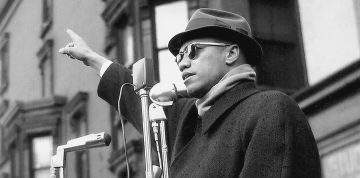Kerri Greenidge in The Atlantic:
 To anyone walking through Roxbury, Massachusetts, the sounds that waft over Dale Street are far away—the fart of buses on Washington Street to the west and on Warren Street to the east. The sidewalk that abuts the bowfront brick rowhouses and wood-frame two-families with porch railings and multiple mailboxes feels comfortably quiet. And it is possible to forget that the recently renamed Nubian Square—Roxbury’s central business district—is less than a 10-minute walk away. In the early 1940s, when Boston’s El towered over what was then called Dudley Square, Ella Mae Little-Collins purchased a two-and-a-half-story house at 72 Dale Street, not far from Washington Park, and invited her 15-year-old half brother, Malcolm, to move in with her. Over the next five years, until he was arrested in January 1946 on charges of larceny, breaking and entering, and illegal possession of a firearm, Malcolm Little lived off and on at No. 72, walking the streets of Roxbury and the South End in his wide-brimmed hats and zoot suits.
To anyone walking through Roxbury, Massachusetts, the sounds that waft over Dale Street are far away—the fart of buses on Washington Street to the west and on Warren Street to the east. The sidewalk that abuts the bowfront brick rowhouses and wood-frame two-families with porch railings and multiple mailboxes feels comfortably quiet. And it is possible to forget that the recently renamed Nubian Square—Roxbury’s central business district—is less than a 10-minute walk away. In the early 1940s, when Boston’s El towered over what was then called Dudley Square, Ella Mae Little-Collins purchased a two-and-a-half-story house at 72 Dale Street, not far from Washington Park, and invited her 15-year-old half brother, Malcolm, to move in with her. Over the next five years, until he was arrested in January 1946 on charges of larceny, breaking and entering, and illegal possession of a firearm, Malcolm Little lived off and on at No. 72, walking the streets of Roxbury and the South End in his wide-brimmed hats and zoot suits.
When he described 1940s Black Boston to Alex Haley as they worked together on The Autobiography of Malcolm X, two decades of distance had left him with barely concealed disdain for the Dale Street neighborhood. The cocky teenager had once marveled at the number of Black people in Dudley Square and the upper South End. But the man known variously as “East Lansing Red,” Prisoner 22843, Malcolm X, and Malik el-Shabazz told Haley that the enclave where he and Ella once lived was a bastion of middle-class Black pretension and snobbery. Yet despite this disavowal, Black Boston had a profound effect on the figure whom the artist-activist Shirley Graham Du Bois later referred to as “the most promising and effective leader of American Negroes in this century.”
More here.
